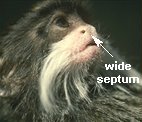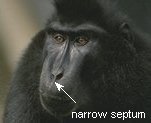In addition to the
tarsiers, there are at
least 145 living species of the suborder Haplorrhini
(the anthropoids). Over 90% of them are monkeys. The remaining species
are apes and humans. The anthropoids have been the most successful
primates in populating the earth. They are generally larger, more intelligent, and
have more highly developed eyes than the prosimians.
There are
two distinct Parvorders of anthropoids that have been evolving independent of each other for at
least 30,000,000 years. They are the Platyrrhini
![]() (New World monkeys)
and the Catarrhini
(New World monkeys)
and the Catarrhini
![]() (Old
World monkeys,
apes, and humans). These
two diverse groups of species
can be distinguished from each other most easily based on the form of their noses and by
the number of specific types of teeth.
(Old
World monkeys,
apes, and humans). These
two diverse groups of species
can be distinguished from each other most easily based on the form of their noses and by
the number of specific types of teeth.
The
platyrrhine
![]() nose (on the left below) is relatively flat with
somewhat sideways projecting nostrils separated by a wide septum. In contrast, the catarrhine
nose (on the left below) is relatively flat with
somewhat sideways projecting nostrils separated by a wide septum. In contrast, the catarrhine
![]() nose (on the right below) has more downward projecting
nostrils separated by a small septum. If you look at
your face in a mirror, you will see the typical catarrhine nose with its
narrow septum.
nose (on the right below) has more downward projecting
nostrils separated by a small septum. If you look at
your face in a mirror, you will see the typical catarrhine nose with its
narrow septum.
|
|
|
|
|
Nose comparison of a
New World monkey--the emperor tamarin (left) |
||
All primates have essentially the same kinds of specialized mammalian teeth adapted to eating a wide variety of foods. Beginning at the front, each quadrant of the mouth has 2 incisors, 1 canine, and varying numbers of premolars and molars. The incisors are used like scissors for nipping off pieces of food. The pointed canines are for piercing and tearing. The premolars (or bicuspids) and molars, with their multiple cusps, are used to grind and smash food. In platyrrhine species, there are 3 premolars and 2 or 3 molars. This results in a dental formula of 2.1.3.2 or 2.1.3.3. In contrast, all of the catarrhines have 2 premolars and 3 molars, making a dental formula of 2.1.2.3. The chimpanzee shown below is an Old World anthropoid species and, therefore, has a catarrhine dental formula.
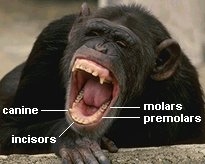 |
| Catarrhine 2.1.2.3 dental
formula (common chimpanzee) |
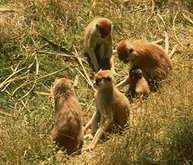 |
|
|
Patas monkeys in an African |
|
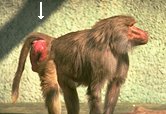 |
|
|
Female hamadryas baboon in |
|
All Old World monkeys, apes, and humans share this 2.1.2.3 dental formula. This not only sets us apart from New World monkeys and prosimians, but it also reflects the evolutionary closeness of the Old World anthropoid species. By comparison, the general placental mammal dental formula is 3.1.4.3.
In addition to these differences, New World monkeys are almost exclusively arboreal and most of them are smaller than Old World monkey species. Some Old World monkeys and apes are semi-terrestrial. If you see a group of monkeys casually walking around in a grassland environment (like those shown on the right), you can be sure that they are from the Old World.
Many of the larger New World monkeys have prehensile, or grasping, tails that are capable of being used as strong "third hands" for holding onto branches. They can even hang from their tails. None of the Old World monkeys or apes has this capability.
Many
species of Old World monkeys have ischial callosities
![]() , or hairless callous pads, on their rumps which may be
adaptations for long periods of sitting or sleeping on rough branches and rocks.
This trait is shared by the small apes of Southeast Asia (gibbons and siamangs).
However, New World monkeys do not have it.
, or hairless callous pads, on their rumps which may be
adaptations for long periods of sitting or sleeping on rough branches and rocks.
This trait is shared by the small apes of Southeast Asia (gibbons and siamangs).
However, New World monkeys do not have it.
In some
species of Old World monkeys and apes, adult females have
sexual skins or
swellings,
which are nearly hairless large swollen patches of skin around the genital area that
become very prominent when they are in estrus
![]() .
These areas swell with fluids and turn bright pink or red due to hormonal changes
that occur in preparation for ovulation. The sexual skin also produces odors that excite males of the species.
They become highly attentive to the females at this time. In the case of
olive baboons, males are most attracted to females with the largest sexual
skin bulge. Those females tend to have babies more often and
subsequently pass on the genes for this impressive signal of sexual readiness.
.
These areas swell with fluids and turn bright pink or red due to hormonal changes
that occur in preparation for ovulation. The sexual skin also produces odors that excite males of the species.
They become highly attentive to the females at this time. In the case of
olive baboons, males are most attracted to females with the largest sexual
skin bulge. Those females tend to have babies more often and
subsequently pass on the genes for this impressive signal of sexual readiness.
